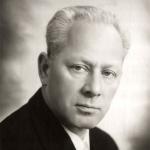
In honour of the outstanding choreographer, on 23 March at the historic Mariinsky Theatre there will be a performance of the ballet Shurale.
“For a great artist, understanding is greater than success and dearer than glory” – these are Leonid Yakobson’s words about the undeservedly forgotten masterpieces of his great predecessor Marius Petipa. If we look through the prism of fate at the man who said them, we understand how much of suffering there was in these words.
Yakobson did enjoy success: his ballets met with ovations at the Kirov and Bolshoi Theatres, and the hearts of audiences were touched by the productions the ballet-master created in his later years for his own company Choreographic Miniatures. He also enjoyed glory: people spoke of him and rushed to see his productions. Memories of Yakobson’s Spartacus abound in legends. Audiences of the 1950s were drawn not just by the incredible beauty of the action onstage, but also by the novelty of the expressive language – the ancient bas reliefs brought Aram Khachaturian’s music to life, and the dazzling embodiment of the idea of stylisation drove the public wild. He had glory and success. But did he have understanding?
Yakobson never attained the understanding of the authorities in this world – there were interminable conflicts with officials and the committees that approved productions, there were the debacles of official discussions of his works and attempts to make him prove the lack of an “anti-Soviet mood” in his ballets and miniatures and to abandon his ideas (the ballet The Twelve after the poem by Alexander Blok was performed just four times, and on each occasion with a different finale). That was the case throughout his artistic life. “They don’t like geniuses,” he said of himself – immodestly but incredibly precisely. They hated Yakobson for his nonconformity, his artistic love of freedom and his obsession. The only thing that directed him in his work was his own imagination. It was this that provided the imagistic dance language of his miniatures, the “fresco” style of Spartacus, the merciless satire of The Bedbug and the fantastical nature of Land of Miracles.
Yakobson found understanding among those who did not provide him with “stars” – his colleagues in various creative departments. Contemporaries referred to him as a “choreographer by grace of God” and a “prophet of the future”, they admired the boldness of his use of young composers, they noted the choreographer’s instinct for talent and his ability to develop it. Yakobson always staged his works for specific performers. He didn’t turn up with pre-planned movements; instead he moulded his masterpieces from the bodies and souls in the studio. That’s why working with him was always a chance for dancers to discover themselves, and the choreographer always took into account the individuality of each performer, every time revealing a new star, albeit in a small role yet never the less that dancer’s own role. Yakobson enriched more than one generation of great performers with his choreography and brilliant lessons of expressiveness – Alla Shelest, Askold Makarov, Alla Osipenko, Natalia Makarova and Mikhail Baryshnikov...
The great choreographer’s works are priceless as an example of original dance invention, compositional decisions, directing ideas and a staggering variety of expressive means: here there are sketches of folk, everyday and fairytale themes; there is classicism, there is stylisation and there is the grotesque. Yakobson was called a recusant, an innovator or, lovingly, a madman. And our memories of his tireless creative imagination and immodest certainty of his own genius, of his energy which set light to everything it touched and his conviction that proved better than any words the rightness of the path he chose will live forever.